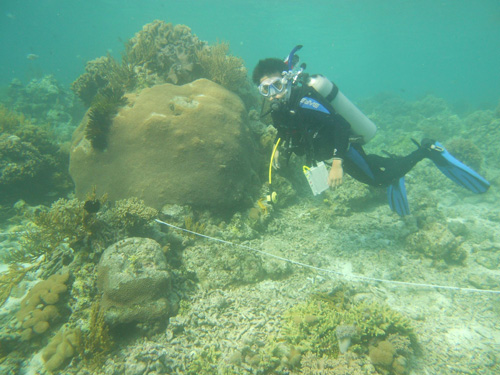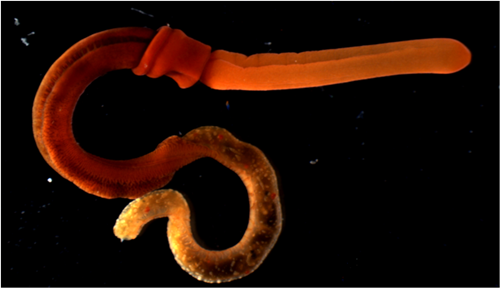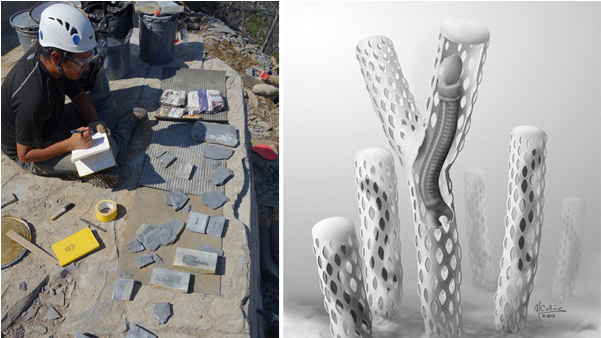The secret of Oesia: a Burgess Shale mystery, by Karma Nanglu
Published
Categories
Author
Blog Post
My name is Karma Nanglu and I’m a PhD student at the University of Toronto, but on a day-to-day basis I do my research at the Royal Ontario Museum. I’ve recently co-authored a research paper, Cambrian suspension-feeding tubicolous hemichordates, with Jean-Bernard Caron, Curator, Invertebrate Palaeontology, Royal Ontario Museum and Associate Professor in the Departments of Earth Sciences and Ecology & Evolutionary Biology at the University of Toronto; Professor Simon Conway Morris, Palaeobiology, University of Cambridge; and Christopher B. Cameron, Associate Professor, Départment de Sciences Biologiques, Université de Montréal. The paper is published in the journal BMC Biology.
Two of my lifelong interests have been biology and travelling, which led me to an undergraduate specialist program in Biodiversity, Ecology and Evolutionary Biology at the University of Toronto Scarborough. During my time as an undergrad I was able to pursue both of these interests, including studying environmental science in Costa Rica, and an undergraduate thesis on the coral communities of the Wakatobi National Park in Indonesia. By the end of my degree, I was sure that I wanted to continue to be involved in research.

In 2013, I began my PhD at St. George campus and the ROM under the supervision Dr. Jean-Bernard Caron. My research is focused on the biodiversity of the Marble Canyon fossil site discovered in 2012, both at the level of an individual species and the community of organisms as a whole. This site, located in Kootenay National Park in the Canadian Rockies, is part of the 508 million year old Burgess Shale geological formation. By investigating fossil animals from this time period, we get an unmatched view of some of the first complex ecosystems to have developed on this planet.
My first project integrated a study of modern animals to inform our understanding of their 500 million year old relatives. I travelled to the coast of British Columbia to collect hemichordates, a group of marine animals that inhabit ecosystems all over the world. By conducting experiments to observe the speed and order in which the anatomy of hemichordates degrades after death, we were able to gain unique insight into the forces that would affect a hemichordate’s fossilization process.

In the summer of 2014, I was a part of the crew that returned to the Marble Canyon to continue collecting fossils. The 2012 and 2014 expeditions combined have yielded thousands of fossils and dozens of species. One of the most abundant species at Marble Canyon, Oesia disjuncta, is the focal point of our recently published article. Oesia disjuncta was first described as a bristleworm in 1911 by Charles D. Walcott, the discoverer of the Burgess Shale fossils in Yoho National Park. Since then, the classification of Oesia has jumped between numerous evolutionarily distant animal groups.

The Marble Canyon specimens of Oesia are far more abundant, preserving an unprecedented level of anatomical detail and concluding unequivocally that it is in fact a hemichordate. Just as crucially, the Marble Canyon specimens show definitively that Oesia disjuncta lived inside of a tube previously considered to be an alga named Margaretia dorus. Our project combined specimens discovered over a century ago with others discovered by a ROM-led research team within the last three years. This has revealed more about the creature and the evolutionary history of an animal group with an otherwise exceptionally poor fossil record.
Karma Nanglu on Twitter: @KNanglu
News Coverage
Calgary Herald - Burgess Shale study finds prehistoric worm built tube-like 'housing' on sea floor
BBC - Sea worm fossil gives clues to 'common ancestor'
CienciaPlus.com - Conoce a Oesia, el gusano prehistórico que vivía en tubos submarinos
Planet Today - На морском дне обнаружены жилища доисторического червя
CBC - Penis-shaped fossils from Canadian Rockies solve century-old mystery
Globe and Mail - New fossil discovery combines two species into one
New York Time - 500-Million-Year-Old Worm Was an Undersea Architect
Further Reading
Media Rlease for The secret to an Oesia life: Prehistoric worm built tube-like “houses” on sea floor
The study, Cambrian suspension-feeding tubicolous hemichordates, is published in the journal BMC Biology. DOI 10.1186/s12915-016-0271-4
The this other ROMblog post to learn more about the discovery of the Marble Canyon fossil site Mighty Burgess Shale fossil site discovered in Kootenay National Park
For more about the fascinating Burgess Shale fossils and the Cambrian Explosion, visit The Burgess Shale website, created by the ROM & Parks Canada.
Specimens from this research are on display in The Willner Madge Dawn of Life Gallery.


